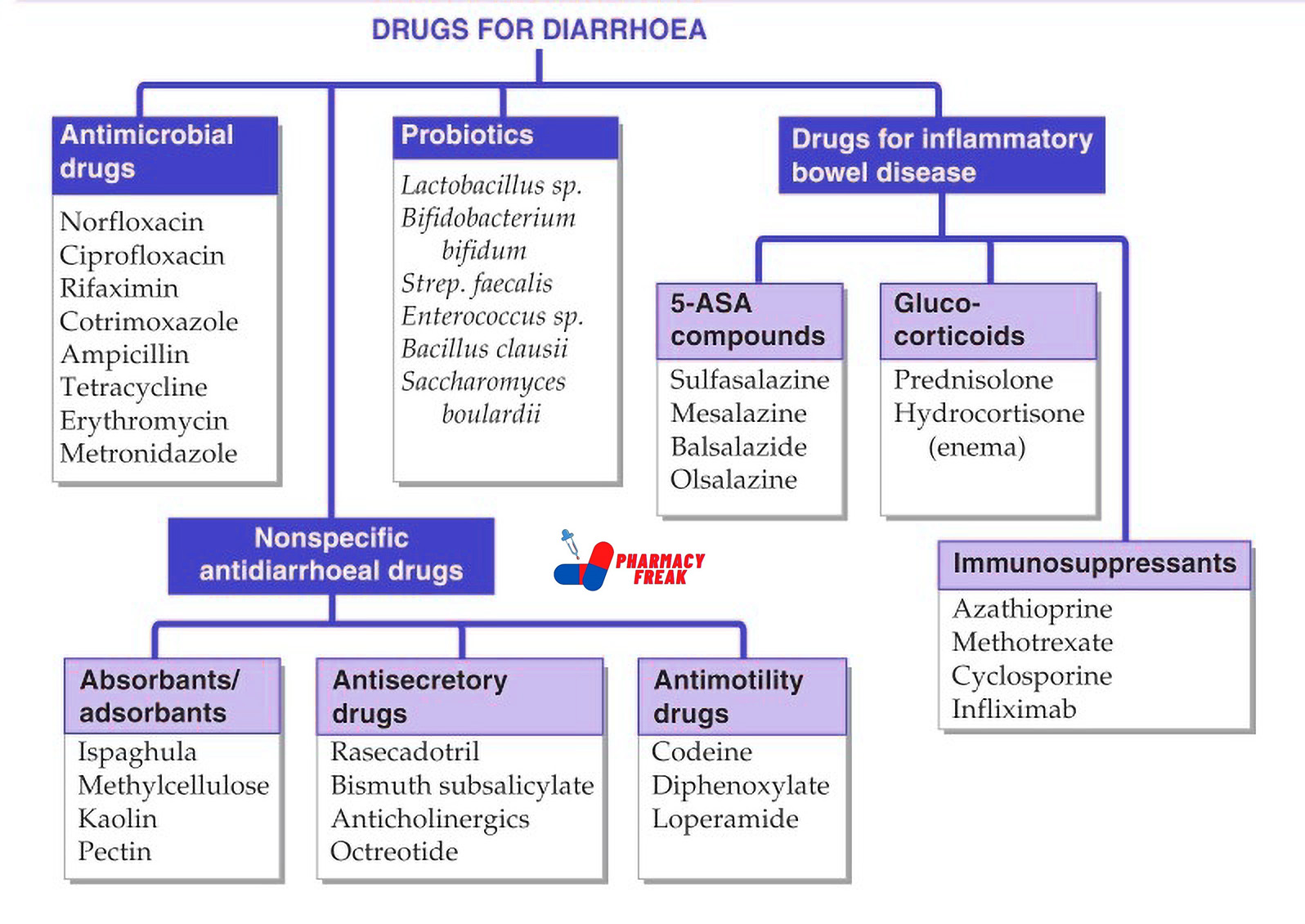- Diarrhoea is a common symptom, not a disease, caused by infections, inflammation, toxins, or digestive disorders. Managing diarrhoea requires a strategic approach involving hydration and specific drug therapies.
- In this blog by Pharmacy Freak, we explore the classification of antidiarrheal drugs, their mechanisms, and clinical applications. We’ve also included standard references from Sparsh Gupta, KDT, and Goodman & Gilman’s, making it ideal for exam preparation and real-world understanding.

- PHARMACY-FREAK
Table of Contents
🔍 What Are Antidiarrheal Drugs?
Antidiarrheal drugs reduce the frequency and urgency of stools. They work by:
- Killing infective organisms
- Slowing intestinal motility
- Enhancing fluid absorption
- Replenishing healthy gut bacteria
- Reducing secretions
📊 Classification of Antidiarrheal Drugs
The drugs are divided into five main categories:
🧪 1. Antimicrobial Drugs
These are used when the diarrhea is infectious in origin — particularly bacterial or protozoal.
- Fluoroquinolones: Norfloxacin, Ciprofloxacin
- Rifaximin – Poorly absorbed; acts within the gut
- Cotrimoxazole – Used in travel-related diarrhea
- Ampicillin – Occasionally used in children
- Tetracycline, Erythromycin – Useful for Vibrio cholerae
- Metronidazole – DOC for amoebic and Clostridium difficile-associated diarrhea (Sparsh Gupta)
✅ Note: Antimicrobials are not used in all diarrhoea cases. They are avoided in most viral infections and mild food poisoning cases unless warranted.
🦠 2. Probiotics
Probiotics restore gut flora that may be disrupted by infection or antibiotic use. They help maintain mucosal integrity and reduce pathogen adhesion.
Commonly used strains:
- Lactobacillus spp.
- Bifidobacterium bifidum
- Streptococcus faecalis
- Bacillus clausii
- Enterococcus spp.
- Saccharomyces boulardii – Effective in antibiotic-associated diarrhoea and pseudomembranous colitis (KDT)
💊 3. Nonspecific Antidiarrhoeal Drugs
These provide symptomatic relief and are used in functional or chronic diarrhoea when no clear infection is identified.
A. Absorbents/Adsorbents
- Kaolin
- Pectin
- Ispaghula (Psyllium)
- Methylcellulose
These bind toxins and excess water in the intestine.
B. Antisecretory Agents
- Racecadotril – Reduces intestinal secretion by acting on enkephalinase (DOC in pediatric acute diarrhoea – Sparsh Gupta)
- Bismuth Subsalicylate – Anti-inflammatory and mild antimicrobial
- Anticholinergics – Reduce motility and secretion (e.g., atropine, dicyclomine)
- Octreotide – Used in VIPoma and chemotherapy-induced diarrhoea (Goodman & Gilman)
C. Antimotility Agents
- Loperamide – Acts on μ-opioid receptors; DOC for traveller’s diarrhoea (unless invasive)
- Diphenoxylate + Atropine
- Codeine – Occasionally used; can cause dependence
🔺 Caution: Avoid antimotility agents in bloody diarrhoea, high fever, or suspected C. difficile infection.
🔥 4. Drugs for Inflammatory Bowel Disease (IBD)
Used in chronic diarrhoea associated with Ulcerative Colitis or Crohn’s disease.
A. 5-ASA Compounds
- Sulfasalazine – DOC for ulcerative colitis
- Mesalazine (Mesalamine) – Better tolerated
- Balsalazide, Olsalazine – Colon-targeted prodrugs (KDT)
B. Glucocorticoids
- Prednisolone – Used during acute flare-ups
- Hydrocortisone enemas – Local application for distal disease
C. Immunosuppressants
- Azathioprine
- Methotrexate
- Cyclosporine
- Infliximab – A TNF-α inhibitor used for moderate-to-severe IBD resistant to steroids (G&G)
📈 Current Guidelines & Clinical Pearls
Based on the latest editions:
- Racecadotril is safer in children than loperamide and preferred in acute viral diarrhoea (Sparsh Gupta).
- Rifaximin is the DOC for noninvasive traveler’s diarrhoea (e.g., E. coli).
- In C. difficile colitis, Metronidazole is first-line for mild cases, while Vancomycin is reserved for severe cases (Goodman & Gilman).
- In IBD, 5-ASA derivatives are started first, followed by steroids and immunomodulators if no response.
📚 References
- Tripathi KD. Essentials of Medical Pharmacology. 7th ed. Jaypee Brothers Medical Publishers,Chapter-48 Drugs for Constipation and Diarrhea
- Gupta S, Garg A. Review of Pharmacology. 15th ed. Jaypee Brothers; 2023. p. 246–249.
- Brunton LL, Chabner BA, Knollmann BC, editors. Goodman and Gilman’s: The Pharmacological Basis of Therapeutics. 12th ed. McGraw-Hill; 2011. p. 1103–1108.
Related Links

I am pursuing MBA in pharmaceutical management from NIPER Hyderabad with a strong academic record and proven success in national-level pharmacy entrance exams. I secured AIR 61 in NIPER 2024 (MS/M.Pharm) and AIR 27 in NIPER MBA, along with AIR 147 in GPAT 2024 and AIR 907 in GPAT 2023. I also achieved AIR 6 in AIIMS CRE-2025 for Drug Store Keeper and was selected as a Pharmacist (AIR 61) for ESIC. Additionally, I was the Runner-Up in Round 2 of the EY Case Study Competition.
At PharmacyFreak.com, I aim to guide future pharmacists through expert content, exam strategies, and insightful resources based on real experience and academic excellence.
Mail- harsh@pharmacyfreak.com
